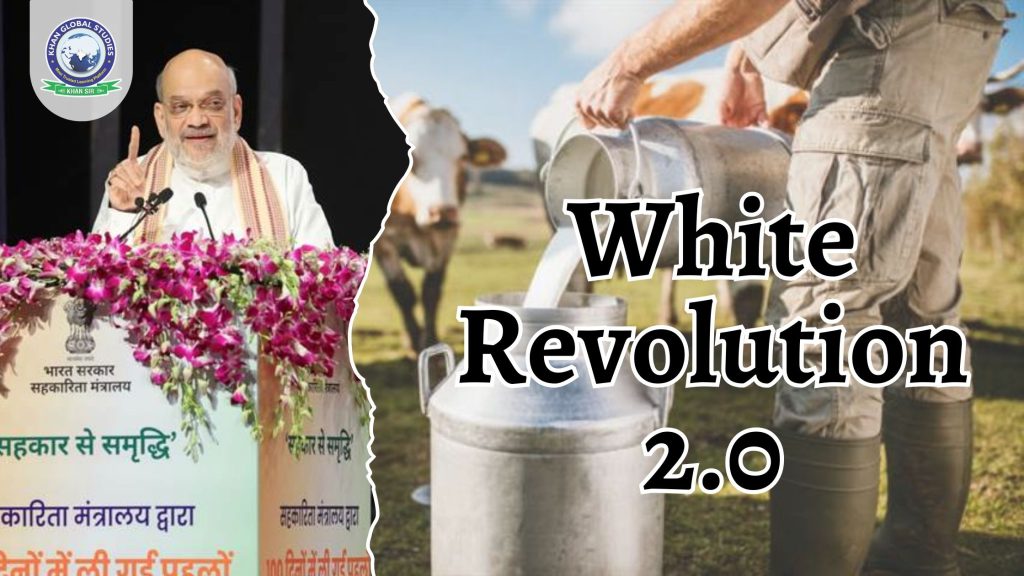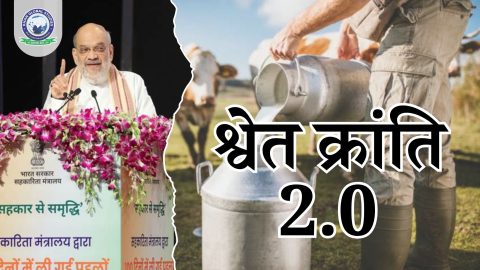Recently, the Union Minister of Cooperation introduced the Standard Operating Procedure (SOP) for White Revolution 2.0, a transformational initiative designed to advance women farmers as well as create abundant employment opportunities. The original White Revolution, a landmark effort that established India as a global leader in milk production, is now set for massive growth. This new chapter seeks to strengthen the dairy sector, uplift rural farmers, and strengthen the country’s economic fabric.
News Analysis
Along with the launch of White Revolution 2.0, the minister also unveiled ‘Margdarshika’, a guideline to streamline the formation and strengthening of 200,000 new multipurpose primary agricultural cooperative societies (MPACS), including dairy and fisheries cooperatives. Additionally, a specific SOP for collaboration among cooperatives was introduced, mandating the opening of bank accounts for all cooperatives in the cooperative bank sector.
Key Focus Areas of White Revolution 2.0
This progressive initiative focuses on four crucial areas:
- Empowering women farmers, ensuring they play a more vocal role in the dairy landscape.
- Increasing local milk production to meet growing demand.
- Strengthening dairy infrastructure, facilitating smooth operations and reducing inefficiencies.
- Expanding dairy exports, making Indian dairy products accessible to international markets.
Strategic Goals
The initiative aims to increase the daily milk procurement done by cooperatives from 660 lakh litres in 2023-24 to 1,000 lakh litres by 2028-29. Additionally, a nationwide launch of RuPay Kisan Credit Cards exclusively for dairy farmers was also done, with plans to set up micro-ATMs in dairy cooperatives to further streamline operations.
The Legacy of White Revolution 1.0
White Revolution 1.0, also known as Operation Flood, was launched in 1970 and is an important chapter in India’s dairy history. Visionary Dr. Verghese Kurien is considered the father of this revolution, which spread across three influential phases:
- Phase I (1970-1980) was made possible by the sale of skimmed milk powder and butter oil donated by the European Union through the World Food Programme.
- Phase II (1981-1985) saw the number of milk-shed areas increase from 18 to 136, while milk was offered at 290 shops in urban markets. By 1985, a self-sustaining system of 43,000 rural cooperatives was established.
- Phase III (1985-1996) saw the number of dairy cooperatives increase to 73,000, along with vast improvements in dairy infrastructure.
Pillars of White Revolution 2.0
The new chapter of the White Revolution is based on several key pillars:
- Increasing Milk Procurement: Significantly boost milk acquisition by cooperatives, ensuring a robust supply chain and greater financial returns for farmers.
- Empowering Women Farmers: A key focus, aimed at providing women with leadership roles, training, and greater resource access, thereby strengthening their contribution to the dairy sector.
- Dairy Infrastructure: This pillar emphasizes on upgrading infrastructure, reducing waste, and improving product quality through modern facilities.
- Promoting Exports: India intends to position itself more competitively in global dairy markets, generating additional income for the sector.
- Sustainability in Dairy: This initiative promotes sustainable dairy farming practices to reduce environmental impacts and advance animal welfare.
Benefits of White Revolution 2.0
- Rural Development: By creating jobs and improving living standards, this initiative has immense potential to drive rural progress.
- Nutrition and Health: Ensuring widespread access to milk and dairy products is critical to improving public nutrition.
- Economic Growth: Expanding the dairy sector can significantly impact India’s economy by generating revenue and promoting innovation.
- Self-reliance: Building on the success of White Revolution 1.0, the latest version seeks to strengthen India’s self-reliance in milk production, thereby contributing to food security.
Current Dairy Status of India
Dairy remains the largest agricultural commodity in India, contributing 5% to the national economy and providing livelihoods to over 80 million farmers. As the world’s leading milk producer, India contributes 25% to the global milk supply, but the country’s productivity levels lag behind Western countries. For example, exotic and crossbred cattle yield only 8.55 kg of milk per day, while indigenous breed cattle yield only 3.44 kg of milk per day. Despite this, India’s per capita milk availability in 2022-23 was 459 grams per day, higher than the global average of 322 grams.
According to Basic Animal Husbandry Statistics (BAHS) 2023, five major milk-producing states—Uttar Pradesh, Rajasthan, Madhya Pradesh, Gujarat, and Andhra Pradesh—collectively account for more than 53% of India’s total milk production.
Conclusion
The White Revolution 2.0 represents a bold leap forward in India’s quest to modernise its dairy sector while promoting sustainability, rural empowerment, and economic growth. By focusing on women empowerment, enhancing infrastructure, and entering global markets, the initiative promises to ensure a prosperous future for millions of farmers and strengthen India’s position as a global dairy leader. This revolution stands not only as a means of increasing milk production but also as a multi-pronged strategy to advance rural development and ensure national food security.



